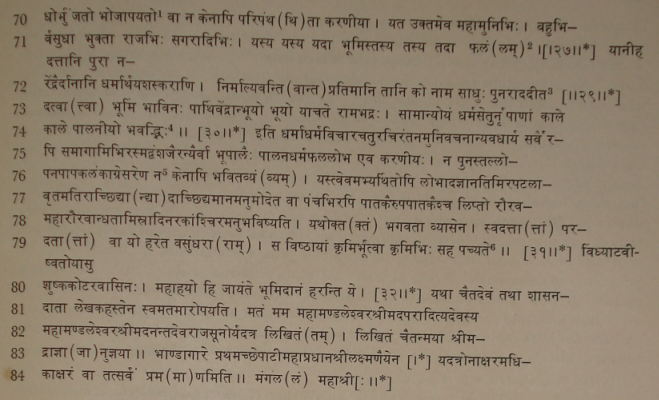|
The Indian Analyst
|
North Indian Inscriptions |
INSCRIPTIONS OF THE SILAHARAS OF NORTH KONKAN
TRANSLATION Om ! Obeisance to Vinayaka ! ..(For the translation of verses 1 to 17, see that of the verses 1-11, 13, 15-17, 20 and 22 of No. 14 above, and for the translation of verse 18, see that of verse 23 of No. 19 above.) .. (Verse 19). Thereafter, the illustrious king, Aparājita by name, the son’s son of the illustrious Nāgārjuna, having conquered the world, became capable of protecting it. While he is ruling over the earth, religious merit is shining, fortune is blooming, majestic lustre is expanding, valour is rising, and good qualities are being highly valued—
..(V. 20). There was a demon, the destroyer Chhittukka, who (was born) to devastate the world. All the feudatories gathered round him. When the wealth of religious merit was destroyed, the elders perished, refugees were harassed, all townsmen and their servants were ruined, and all prosperity of the kingdom came to an end— ..(V. 21). He (Aparāditya), seeing that situation, rushed suddenly to the fierce battle single-handed, with only one horse (which he rode), his arms and his sword (to help him). The enemy did not know whether to fight or to run away. (Ultimately), being afraid of him, he sought refuge with the Mlēchchhas. ..(V. 22). May that illustrious Aparājita—the treasure of courage, generosity, discrimination and valour, the ocean of serenity, the sole store of good fortune, the well-known and shining limit of music and learning, a second Arjuna in regard to the skilful use of arms, of limitless valour and a rich store of wealth to good people—live for a thousand years !
..
(Line 37). Now, in the beneficial and victorious reign of the Mahāmaṇḍalēśvara, the
[1] Read भोजयतो.
|
|||||||||||||||||||||||||||||||||||||||||||||||||||||||||||||||||||||||||||||||||||||||||||||||||||||||||||||||||||||
| > |
|
>
|








